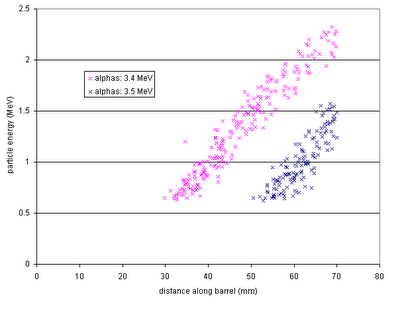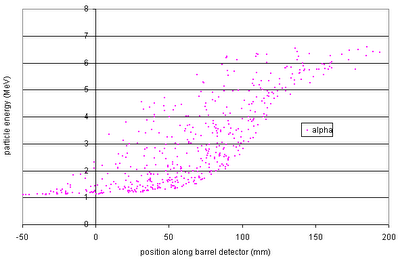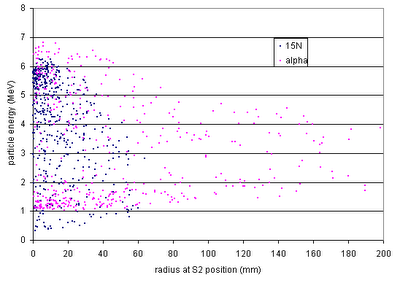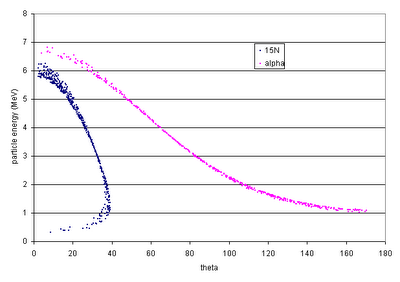14N hits on S2, with some corresponding alpha hits... (I said proton before--I meant alpha!)

...and the remaining corresponding alphas on the "barrel" detectors...

2. 10 Torr: elastic proton rate:
I made a...let's call it a careless oversimplification with the angular distribution for the previous proton rate calculation; but I don't think it had much of an effect. On the other hand, the incorrect number of atoms in the target that I used DID have an effect--the rates I calculated were at least an order of magnitude too high. I did a very detailed new calculation of energy losses for the protons.
The input:
H2 gas: pressure=10 Torr, total cell length=10 cm
beam: 3.3 MeV 17O
detectors: S2 and barrel detectors in the now-standard positions
scattering cross-section: calculated by Tom
atoms in target: 7e16 atoms/cm2
beam current: 1e11 pps
protons to damage detector: 1e11 per cm2
The results:
520 000 protons/s in barrel; 970 000 protons/s in S2
--> 5200 protons/cm2/s in barrel; 28 000 protons/cm2/s in S2
--> 1.9e7 s to damage barrel; 3.6e6 s to damage S2
-->445 (12 h) shifts to damage barrel; 83 shifts to damage S2.
If (if) these new calculations are correct, we don't need to worry about limiting beam current to keep from frying the detectors. Also, the rate in a single strip of the S2 would be ~20 000 protons/s (but they could be eliminated by setting a threshold), and there would be a 13% chance of having a proton come in at the same time as a 14N. Not too bad!
3. Calibration reaction:
Chafa and Fox both use the 18O + p --> ElabR=151 keV 19F resonance for calibration. As near as I can tell, that level in 19F has a width Γ>0.3 keV (quite different from the 0.3 eV width of the state of interest in 18F). That means that the width of the state (instead of the beam energy loss in the gas) becomes the dominant factor in the resonance length in the cell.
Here's the kinematic curves for the reaction...

But because the reaction can happen at any point in the cell (instead of at a nicely constrained point like in the 17O+p reaction), the measured energy-versus-detector-position curves are smears...note that the x-axis on both of these plots bears no resemblance to the actual extents of the detectors....


At the least this means that the efficiency for detecting this "calibration" resonance will be quite low and hard to determine. Also, particle identification will be hard in the absence of clear loci for the particles of interest--how will we tell them apart from contaminant reactions?
Comments?
No comments:
Post a Comment